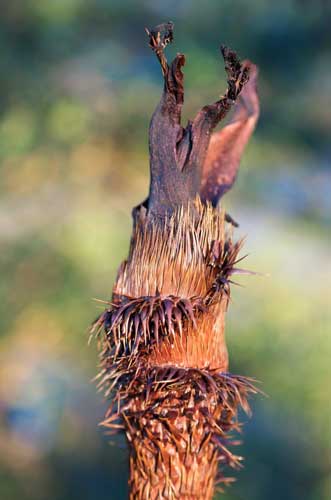Cleve West: The Aralia is good enough to eat
As a delicacy, the Japanese fry the tender, spring endshoots of the aralia tree in tempura

A friend, harping on about how he's one step ahead of the game by planting Aralia elata, the Japanese Angelica tree, needed reminding that he was on a misguided mission. "It's a resolution," he said, "to use some of the more unpopular plants to subvert the latest gardening trends."
As far as I was concerned, aralias aren't that unpopular, so doing my very best to disguise any tone of one-upmanship, I told him that I planted one a couple of years ago.
"Oh, yeah?" he said doubtfully. "Well why haven't you written about it then?"
Good point. Truth is, I thought I had, so it was probably in passing while writing about fatsia, another member of the aralia family. If, however, I have written about it and you are one of the few readers to remember the article, then apologies for going over it again but I really must win this argument otherwise I'll never hear the end of it.
A couple of years ago, in the spirit of community gardening, I planted up a small bed in our cul-de-sac with a mixture of rosemary, fennel, alchemilla and Stipa gigantea. Escallonia resinosa was also planted to provide some evergreen bulk in the middle. Pre-empting the demise of a nearby cherry (at least 35 years old), I had planned on planting a small tree – something that wouldn't dominate but would provide enough height and architecture to take some of this responsibility away from the escallonia. Because escallonias, with the best will in the world, don't offer much by way of architecture.
I decided to use the aforementioned aralia, not only because of its large pinnate leaves, white flowers and spiny stem (which makes it look a bit geeky), but also because I was looking for a home for one that had been given to me by the eminent plantsman Jimi Blake after a visit to his beautiful garden in Co Wicklow (huntingbrook.com). Before that I'd also admired them in Helen Dillon's garden in Dublin (dillongarden.com), where her random use of the tree, mimicking its natural proclivity to run and sucker, made a charming space in a gravelled area at the back of the garden. It was winter, so all I was actually admiring were sticks that looked like an eccentric collection of worn-out bottle brushes. Her aim was to pepper the given space with these small trees that wouldn't take up too much space and would shade other plants growing beneath. Jimi Blake allows them to run in borders of perennials and tall grasses such as miscanthus providing a useful contrast without making the space feel oppressive in any way. The suckering habit of the aralia, a native to Russia, China, Japan and Korea, is not something we need to worry about in the UK. Growing to around 6m (20ft) in ideal conditions (deep, free draining loam) they'll probably reach no more than 3m in poorer soils, making them a useful tree for the urban garden.
I mentioned all this to my friend, not to wind him up (well, OK, maybe just a little because at the moment anyone would think that he invented Aralia elata), but to make him realise that they aren't as unpopular as he thinks and, if he really wants to subvert garden trends, he might think of planting the A. elata 'Variegata' instead, and underplant them with bedding begonias. Too late. He's already bought 10 from Architectural Plants (architecturalplants.com). To his credit he did enlighten me about the aralia's gastronomic secret whereby the tender, spring end-shoots of the tree are fried in tempura – a Japanese delicacy apparently. His idea, though, of planting them as a hedge in a 30cm thin strip of earth by his fence might still provide some entertainment, but I'm keeping well away from now on in case someone thinks I had anything to do with it. Of course, it may well turn out to be the most innovative planting idea of the year. If so, while I may be able to profit from the suckers produced by the tree I planted (mid to late winter is a good time to do this), the words to congratulate such visionary planting will, like the bristles on an ill-prepared tempura-bud, no doubt get stuck deep in my gullet.
Join our commenting forum
Join thought-provoking conversations, follow other Independent readers and see their replies
Comments